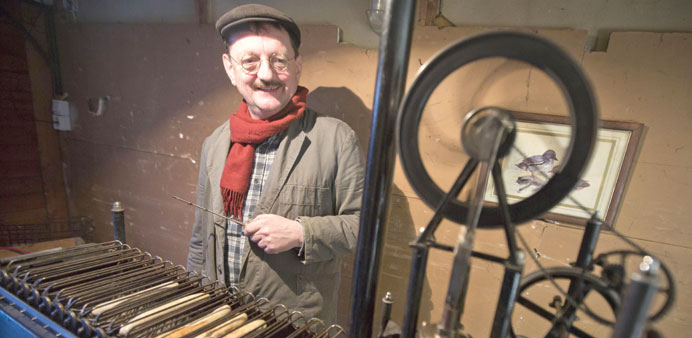Artist-inventor Walter Guenther in his Frankfurt basement workshop with his automated barbecue, which turns sausages so they brown evenly. The Stirling motor at right turns the contraption.
By Sandra Trauner
A barbecue that turns sausages gradually and automatically, a saucepan that knows when the potatoes are done and a hammer drill that needs no electricity to bore holes in brick.
Walter Guenther is the man behind these oddball inventions, most of which have the air of wacky sculptures and would be at home in many art galleries. Each is a one-off, and despite their old fashioned look, they are certainly not relics of the past.
Guenther is an ingenious inventor and his skills were recently acknowledged by a magazine for technological innovation, which awarded him the title of Germany’s most paradoxical inventor, a man who comes up with things which only he feels need to be invented.
Guenther’s workshop lies tucked away in the basement of a building in the north of Frankfurt, Germany’s financial capital. The none-too-spacious room is devoid of windows but stuffed from floor to ceiling with tools and metal off-cuts.
The space is full, yet carefully ordered in Guenther’s mind.
To the rear stands a table with a check-pattern tablecloth and arranged upon it are the favourite creations of this German madcap inventor.
Gunther, 51, has so far come up with 15 different machines and belongs to a tradition of technology as art established by British graphic artist Heath Robinson (1872-1944) and US sculptor Rube Goldberg (1883-1970).
Once a year Guenther takes his sausage-turning machine to an annual street fair held in the district around Frankfurt central station and when visitors come around to his workshop he is happy to demonstrate its advantages.
A Stirling motor chugs away at the end of a rack containing hollows for the wurst. Guenther gingerly inserts the pale sausages into each slot of the automated barbecue.
A series of cogs turns them steadily around their own axes, ensuring that the sausages are evenly browned. Arms folded, Guenther admires his handiwork and points out that he has had enquiries from potential buyers.
As it happens, he cannot be bothered with building any more than a prototype. He is first and foremost an inventor, concerned with the function and appearance of his creations, not a manufacturer.
“If somebody wants one let them build one themselves,” he said with a shrug of the soldiers. “There are no blueprints mind you.”
Guenther receives guests wearing a pair of grey overalls over his checked shirt, with his trademark round spectacles on the end of his nose and a cap. He takes the time to explain clever construction details to visitors unfamiliar with technical matters yet his patience is tried if people refer to his tinkering as a handicraft.
“Handicrafts are for children” he murmurs with a hint of ill humour.
His nature may seem workman-like but deep down Guenther is more of a poet.
“These cranks and cogs are my favourite actors. I come up with the story so that they can act it out for me,” he says, lamenting that a humble display cabinet is not really the right environment for his beloved inventions.
But back to the objects themselves. Take the saucepan which utters shrill whistles like a kettle when the boiled potatoes are tender enough to eat. Guenther calls it an “Aldentomat”. The potato is attached to a spike on a bent spoon at the top.
The spike sinks into the potato when the required softness of texture has been achieved. The spike is linked to weights which seal the holes in the saucepan lid, causing a whistle as the air is forced to escape through a pipe.
Sometimes in the summer months, when his attic flat a few streets away gets a bit too warm, Guenther beds down in his workshop.
He usually wakes to a metallic clamour caused by a candle which activates a flap when it has burned down.
Guenther then sets off for his day job as an instructor at a factory where handicapped people are trained in manual skills. The materials used here are wood and paper although Guether is a metals man.
For him metal stands for “ovens and warmth, for durability and reliability.”
He could have become an engineer but for the fact that he did not have a head for the all figures needed during physics and mathematics instruction. He learned the trade of a metalworker instead and qualified as a master craftsman.
Johannes Kirschenmann, who heads the Academy of Fine Arts in Munich, wrote the foreword to a book about Guenther and his works which was published in Germany a few years ago.
“Both a realist and a dreamer,” was how the professor summed up the inventor, whose “fabulous contraptions epitomise freedom”.
A device known as “Serviette Willi” is one of the few inventions by Guenther to have been registered as a design under European Union law, though it does not have a patent, which is only awarded for completely new technology.
Guenther’s creations are not designed to do anything that was not technically possible before. “I think they tend more towards art”, said Guenther and does not sound too unhappy about it either.
“Technical progress, with its emphasis on making things go higher, faster and further, is not my cup of tea” said Guenther. “I prefer to go back and tread the forgotten byways.”
For chosen friends he likes to make all manner of allied objects and has been an avid reader since boyhood of all things technical.
It once occurred to him that the hammer drills were not actually invented until after the advent of electric power tools.
That started him thinking. Guenther set about building a hammer-action, hand-turned drill. The fact that there is no demand for the device is of no consequence to the intrepid boffin.
“Some inventions emerge and are forgotten while in some cases people have just forgotten to invent them,” said Guenther. — DPA

